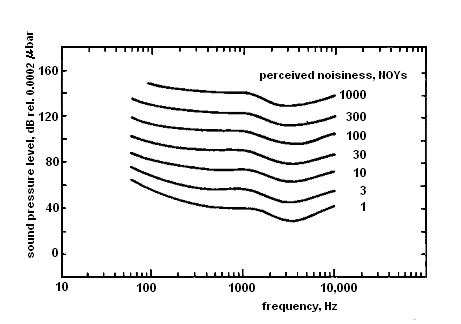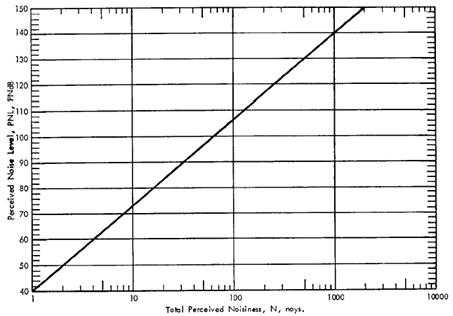Реферат: Tupolev 154M noise asesment (Анализ шумовых характеристик самолёта Ту-154М)
3. Then NEF = ![]() , where the sum is taken over all events in a 24-hour period. A little ciphering will show that this last calculation is equivalent to adding the products of sound intensity times time for all events, then taking the dB equivalent of this. The subtractor 82 is arbitrary.
, where the sum is taken over all events in a 24-hour period. A little ciphering will show that this last calculation is equivalent to adding the products of sound intensity times time for all events, then taking the dB equivalent of this. The subtractor 82 is arbitrary.
4.2 Effective Perceived Noise Level (EPNL)
The perceived noisiness of an aircraft flyover depends on the frequency content, relative to the ear’s response, and on the duration. The perceived noisiness is measured in NOYs (unit of perceived noisiness) and is plotted as a function of sound pressure level and frequency for random noise in Fig. 4.1.

Figure 4.1 Perceived noisiness as a function of frequency and sound pressure level
Pure tones (frequencies with pressure levels much higher than that of the neighboring random noise in the sound spectrum) are judged to be more annoying than an equal sound pressure in random noise, so a “tone correction” is added to their perceived noise level. A “duration correction” represents the idea that the total noise impact depends on the integral of sound intensity over time for a given event.
The 24 one-third octave bands of sound pressure level (SPL) are converted to perceived noisiness by means of a noy table.

Figure 4.2 Perceived noise level as a function of NOYs
Conceptually, the calculation of EPNL involves the following steps.
1. Determine the NOY level for each band and sum them by the relation
![]() ,
,
where k denotes an interval in time, i denotes the several frequency bande, and n(k) is the NOY level of the noisiest band. This reflects the “masking” of lesser bands by the noisiest.
2. The total PNL is then PNL(k ) = 40 + 33.3 log10 N(k).
3. Apply a tone correction c(k) by identifying the pure tones and adding to PNL an amount ranging from 0 to 6.6 dB, depending on the frequency of the tone and its amplitude relative to neighboring bands.
4. Apply a duration correction according to EPNL = PNLTM + D, where PNLTM is the maximum PNL for any of the time intervals. Here
![]() ,
,
where D t = 0.5 sec, T = 10 sec, and d is the time over which PNLT exceeds PNLTM – 10 dB. This amounts to integrating the sound pressure level over the time during which it exceeds its peak value minus 10 dB, then converting the result to decibels.
All turbofan-powered transport aircraft must comply at certification with EPNL limits for measuring points which are spoken about in the next chapter.
5 Noise Certification
The increasing volume of air traffic resulted in unacceptable noise exposures near major urban airfields in the late 1960s, leading to a great public pressure for noise control. This pressure, and advancing technology, led to ICAO Annex 16, AP-36, Joint Aviation Regulation Part 36 (JAR-36) and Federal Aviation Rule Part 36 (FAR-36), which set maximum take-off, landing and “sideline” noise levels for certification of new turbofan-powered aircraft. It is through the need to satisfy this rule that the noise issue influences the design and operation of aircraft engines. A little more general background of the noise problem may be helpful in establishing the context of engine noise control.
The FAA issued FAR-36 (which establishes the limits on take-off, approach, and sideline noise for individual aircraft), followed by ICAO issuing its Annex 16 Part 2, and JAA issuing JAR-36. These rules have since been revised several times, reflecting both improvements in technology and continuing pressure to reduce noise. As of this writing, the rules are enunciated as three progressive stages of noise certification. The noise limits are stated in terms of measurements at three measuring stations, as shown in Fig. 5.1: under the approach path 2000 m before touchdown, under the take-off path 6500 m from the start of the take-off roll, and at the point of maximum noise along the sides of the runway at a distance of 450 m.

Figure 5.1 Schematic of airport runway showing approach, take-off, and
sideline noise measurement stations.
The noise of any given aircraft at the approach and take-off stations depends both on the engines and on the aircraft’s performance, operational procedures, and loading, since the power settings and the altitude of the aircraft may vary.
The sideline station is more representative of the intrinsic take-off noise characteristics of the engine, since the engine is at full throttle and the station is nearly at a fixed distance from the aircraft. The actual distance depends on the altitude the aircraft has attained when it produced maximum noise along the designated measuring line. Since FAR-36 and international rules set by the International Civil Aviation Organization (ICAO annex 16, Part 2) which are generally consistent with it have been in force, airport noise has been a major design criterion for civil aircraft.
Stricter noise pollution standards for commercial aircraft, established by the International Civil Aviation Organization, came into effect worldwide on 1 April. Most industrialized countries, including all EU states, enforced the new rules and the vast majority of airliners flying in those states already meet the more stringent requirements. But some Eastern European countries are facing a problem, especially Russia. Eighty percent of its civilian aircraft fall short of the standards, meaning it will not be able to apply the new rules for domestic flights. Even more worrisome for Moscow is the fact that Russia could find many of its planes banned from foreign skies. Enforcement of the new rules could force Russia to cancel 11,000 flights in 2002, representing some 12 percent of the country's passenger traffic.
The new rules have been applied only to subsonic transports, because no new supersonic commercial aircraft have been developed since its promulgation.
5.1 Noise Limits
As mentioned above, all turbofan-powered transport aircraft must comply at certification with EPNL limits for the three measuring stations as shown in Fig. 5.1. The limits depend on the gross weight of the aircraft at take-off and number of engines, as shown in Fig. 5.2. The rule is the same for all engine numbers on approach and on the sideline because the distance from the aircraft to the measuring point is fixed on approach by the angle of the approach path (normally 3 deg) and on the sideline by the distance of the measuring station from the runway centerline.

Figure 5.2 Noise limits imposed by ICAO Annex 16 for certification of aircraft.
On take-off, however, aircraft with fewer engines climb out faster, so they are higher above the measuring point. Here the “reasonable and economically practicable” principle comes into dictate that three-engine and two-engine aircraft have lower noise levels at the take-off noise station than four-engine aircraft.
There is some flexibility in the rule, in that the noise levels can be exceeded by up to 2 EPNdB at any station provided the sum of the exceedances is not over 3 ENPdB and that the exceedances are completely offset by reductions at other measuring stations.
6 Noise Level Calculations
6.1 Tupolev 154M Description
For most airlines in the CIS, the Tupolev Tu-154 is nowadays the workhorse on domestic and international routes.

Figure 6.1 Tupolev 154M main look
It was produced in two main vesions: The earlier production models have been designated Tupolev -154, Tupolev -154A, Tupolev -154B, Tupolev -154B-1 and Tupolev -154B-2, while the later version has been called Tupolev -154M. Overall, close to 1'000 Tupolev -154s were built up to day, of which a large portion is still operated.
Table 6.1 Tupolev 154M main characteristics
|
Role |
Medium range passenger aircraft |
|
Status |
К-во Просмотров: 1773
Бесплатно скачать Реферат: Tupolev 154M noise asesment (Анализ шумовых характеристик самолёта Ту-154М)
|